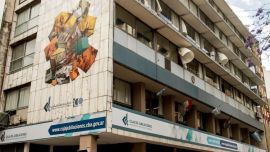When prices rise fast enough for long enough, consumers can lose any sense of what they should’ve been paying in the first place.
That’s an extreme case of what’s known in economics jargon as “unanchored expectations” – and in Argentina, it’s the daily reality.
With inflation at 58 percent and accelerating, the US$500-billion economy is an outlier even in a world where prices are taking off almost everywhere. It’s not just a pandemic-era problem: while the historical statistics are suspect, Argentina hasn’t had single-digit inflation in at least a decade.
The upshot: as prices soar and scatter, people are losing their bearings. No wonder, when a two-hour domestic flight costs the same as a month of college tuition, a pair of sneakers is equal to the minimum monthly social-security payment, and a new iPhone goes for half a year’s average rent or more. Price-tags also vary wildly from store to store, and tracking down the daily essentials at the least-unaffordable rates is a drain on time and energy for working Argentines.
“Nobody knows how much something costs,” says Federico Moll, director of economic research at consulting firm EcoLatina in Buenos Aires. “Talk to any Argentine of a certain age and they probably can tell you how much something went for in the 1990s, but they don’t remember how much something costs today compared to yesterday.”
Wider lessons
Few countries are likely to suffer a melt-up in prices on that scale. It took decades of seesawing politics and zigzags in economic policy for Argentina to get here. Politicians repeatedly failed to keep government spending under control, central bankers kept changing their monetary plans, and the country suffered a currency crisis in 2018 amid a wider flight from high-risk emerging markets.
Still, amid a wave of global inflation there are some wider lessons in Argentina’s experience. First, once prices spiral it can prove almost impossible to get them back under control. Second, political careers will likely end along the way.
Now it’s President Alberto Fernández in the hot seat, with approval ratings that are sliding as prices soar.
His government is publicly at odds over how to deal with inflation. The powerful vice-president, Cristina Fernández de Kirchner, slammed Fernández’s team earlier this month for failing to rein in prices – and said Argentina’s latest agreement with the International Monetary Fund, seen by investors as key to getting the economy on track, will only push costs higher still.
In the latest sign of infighting over inflation, the top official in charge of price controls – a Kirchnerite loyalist – quit last week, citing differences over “the path taken and the economic tools chosen.”
Higher international energy prices have slowed the Central Bank from building up its net foreign reserves, a key aspect of the government’s plan to cool inflation and anchor expectations this year, according to a senior official who asked not to be named to discuss internal conversations.
Rising prices forced the government to pay for natural gas imports earlier than expected, delaying the Central Bank from strengthening reserves. Inflation originally forecast in the IMF programme to end this year between 38 to 48 percent is now seen within a range that may reach 60% percent, the official added.
Argentina’s Economy Ministry didn’t provide comments.
‘Things happened’
The left-of-centre Fernández, who’s up for re-election next year, doesn’t have to look far for a cautionary tale. Through dictatorship and democracy, inflation has doomed Argentine politicians of all stripes.
His immediate predecessor Mauricio Macri came to power in 2015 claiming that a dose of pro-business policy would soon tame prices. Four years later, with inflation not far short of today’s 30-year high, he admitted that “things happened” – before getting booted from office.
Argentines like Dionisa Romero, a janitor in a Buenos Aires apartment block, are now training their fire on Fernández’s administration.
“There’s no controls, the government practically abandoned us,” Romero says while shopping for food and school clothes for her daughter. Some goods are supposed to be available at regulated prices, but Romero complains that she can’t find them: “You go to the supermarket and get one price, you go to the grocery store and get another.”
Economists reckon that one key to controlling inflation is managing expectations for future prices. Good luck with that in Argentina, where people barely even know what things cost right now.
What price coffee?
In the oceanside city of Mar del Plata in April, the same bag of coffee beans cost 200 pesos at one store and 500 pesos at another, according to the latest annual survey by Universidad FASTA. The gap was more than three times bigger than in 2019, when overall inflation was close to today’s levels.
That illustrates how higher-for-longer inflation leads to growing price disparities, according to Gabriel Coronello, a professor in charge of the project, which sends surveyors out to 48 stores every year to measure the same basket of basic foods.
“For a consumer to choose all those products at the minimum price, you’d have to go to 16 stores in one day,” he says.
Since the cost of a grocery run is anyone’s guess, Argentines are fighting to protect their paychecks. In May, labour unions secured raises that averaged 78 percent at an annualised rate, more than double last year’s pace – and potentially further fuel for inflation.
Fernández delivered another upward jolt by raising electricity prices at the start of the month – perhaps the rawest nerve in Argentina’s latest IMF programme.
The government spent US$11 billion last year to keep utility bills flat. It’s promised to slash those subsidies. Pumping less money into the economy should help cool inflation over the longer run. But analysts expect electricity bills to jump about 50 percent this year as a result. Voter fury over a similar policy played a big part in Macri’s defeat in 2019 – one reason why Fernández de Kirchner has slammed the new IMF deal as an election-loser.
At the same time, Fernández has ramped up other budget outlays – offering new income-support payments for 13.6 million low-income Argentines, and raising the federal minimum wage earlier than anticipated, a move that has knock-on effects for social-spending programs.
Measures that push in different directions have been a hallmark of Argentina’s long fight with inflation. In the past four years alone, for example, the Central Bank has gone from inflation-targeting with a free-floating exchange rate, to no targeting under a managed rate with capital controls. Both regimes left inflation above 50 percent.
Ricardo Vallarino, a 68-year-old who’s lived through hyperinflation, debt crises, currency debacles and multiple recessions, is unimpressed with the current hodgepodge of policies – the result, he says, of a government that’s divided over what to do.
“It isn’t a solution,” Vallarino says while out shopping in Buenos Aires. “The solution is lowering inflation with an economic plan.”
related news
by Patrick Gillespie, Bloomberg

























Comments